A female member of the American crocodile species that has been held captive in a Costa Rica zoo for 18 years without contact with any possible mates was recently discovered to have reproduced on her own. In nature, this is called facultative parthenogenesis or “virgin birth,” and as you might suspect, it’s not all that common in nature’s complex creatures. In fact, this is the first time a crocodile has been able to reproduce without mating, as far as recorded science knows.
Yes, crocodiles lay eggs, as opposed to live mammalian births, but this “girl boss” impregnated herself and laid an egg containing a fully formed fetus with DNA, all from the mother and all without a mate. That’s an impressive display of independence.
A few other vertebrate animals that are known to be able to have asexual births include certain birds, fish, and other reptilian creatures. What they all have in common is their ancient connection to dinosaurs. So now, scientists are saying there’s more and more evidence adding up to suggest that asexual reproduction was part of life for some of the dinosaurs that used to roam the Earth.
So does this mean that at least part of Jurassic Park is plausible, updating its status up from BS? Kind of, yeah. While we have all already heard that the whole dino-DNA from a preserved mosquito’s stomach angle isn’t really going to happen, at least with the current things we know about DNA and how it’s preserved, what about the whole female-only population reproducing thing? In the original movie, female dinosaurs were able to reproduce because their DNA had been mixed with amphibian DNA, which has been known to be able to switch sexes in nature.
William Booth, the lead author of a study describing the crocodile discovery, told National Geographic that the new evidence about female crocodiles shows that “if there was a new Jurassic Park movie, there’d be no reason for them to go that far. They could simply say that it’s very likely that dinosaur DNA carried the gene variant that allows for parthenogenesis.”
“Birds and crocodiles are part of this ancient lineage called archosaurs,” Booth explained. “I think it’s a very ancient trait that was never lost from the ancient lineages from which other organisms evolved.”
If you’re wondering whether—since big, fairly common animals like American crocs can suddenly be found to have the capacity for asexual reproduction—mammals will be far behind, you may be disappointed. Rather than a newly developed skill, it seems likely that it’s the crocodile’s ancient roots that gave it the capacity for facultative parthenogenesis. For the moment, stay skeptical if you hear about any “virgin births” in the human community.
(featured image: Universal Pictures)









Published: Jun 20, 2023 11:48 am